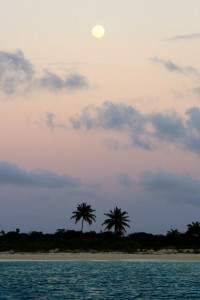
On a sailboat at sea at night, the only company you have is the wind, the waves, the bioluminescence (if the water is clean), the stars (if the sky is clear) and the moon (if you’ve timed your passage with the lunar calendar). In the Caribbean waters we’ve been traversing, you can go an entire night without seeing a single other boat. It is peaceful, listening to the waves roll over the hull, watching the moon cross the sky, searching for shooting stars, being totally uninterrupted in your contemplation of your place in the world. Then there are the highly trafficked nights, when a cruise ship crosses your bow and a freighter takes your stern, all within a single night watch. It makes the New York Harbor, where we grew up sailing, seem like bumper boats or frogger.
When a boat does appear out here at night, it begins as a faint light far off on the horizon. You check the charts to make sure it isn’t land or a lighthouse. You watch it for the better part of fifteen minutes, trying to determine from the faint light in which direction it is travelling, how fast it is moving and whether it is under sail or motor. Finally, it appears on AIS, and you get its name, its dimensions, its speed and its destination. In these waters, it will be a cargo ship, a tanker or a cruise ship; it will be travelling at fifteen to twenty knots; it will be nearly one thousand feet long with a draft of more than thirty feet. Our tank of a sailboat could practically capsize in its bow wake, and it certainly wouldn’t even feel a bump if it took us under. When you’re travelling under seven knots (and down the Thorny Path, we travelled well under seven knots) with forty feet of length and a draft of less than five feet, and the only vessel you see is a freighter or a cruise ship, you feel very, very small, very, very slow and very, very vulnerable.
On s/v Blue Moon (an Island Packet 380), it’s just Jason and I, with our dinghy Moon Shadow hanging onto the arch in back and our kayak Sunshine tied down to the stations up front. If I’m on watch, Jason is asleep on the leeward side of the salon downstairs. I am outside, in the dark, alone. I’m usually reading a book with my red headlamp, getting up every page or two to check the horizon and the chartplotter, and doing some lunges and squats every hour to keep the blood flowing. After a big swell that crashes over the bow and rushes down the decks, giving Sunshine a good wash down and Moon Shadow a good bump on her belly, I might thank Blue Moon for riding the wave so well or coax Sunshine and Moon Shadow into holding on tight. But other than that, it’s the closest thing to peaceful solitude this city girl has ever experienced.
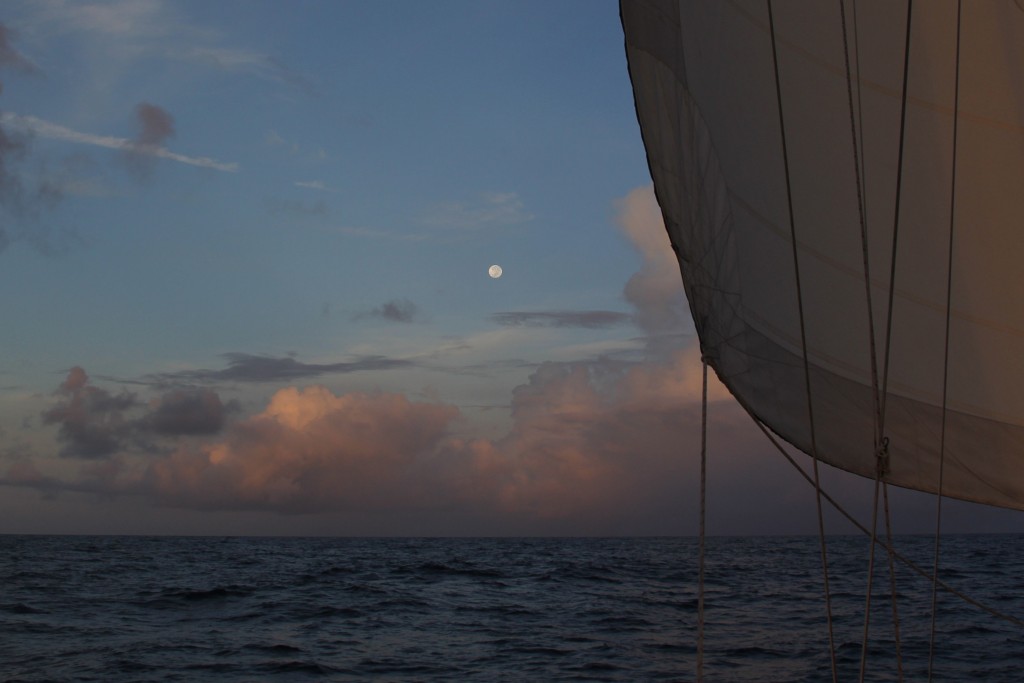
At first you’re so excited to see another boat: something to train your tired eyes on, a little intrigue to get the blood flowing, the chance of a conversation over the radio if they want to confirm your intentions. (Yes, confirm the slow little sailboat’s intentions. Out here, in most scenarios, we are the stand-on vessel, and any vessel under power must give way to us, which is easier if they know what coarse we intend to sail.) Then the boat gets closer, and you are dwarfed by its hull, blinded by its lights. It’s burning more fuel in an hour than we usually do in a year. And it’s dumping garbage and sewage out its back. You’re not so sure you want to be sharing the sea with this behemoth.
Until it falls off the face of the earth, or sinks into the ocean. Or at least you think it does. Or you think you only imagined seeing it in the first place. You are tired, you are slightly sea sick, your eyes are burning from the salt and wind and lack of sleep. You were sure you saw a boat, and then it’s gone. You think you see it again, a few seconds later, and then it disappears again. As it intermittently approaches you and you start to get your wits about you, you realize your view of the boat is obscured by the massive waves rolling between the two of you. You are calmed to know that the boat is not sinking into some uncharted abyss and you are not seeing things. But will it see us? Is our light at the top of the fifty-foot mast tall enough to reach them over the fifteen-foot waves?
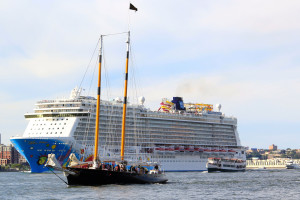
It’s likely a mile off your bow by the time you start to panic. It feels as though it’s right upon you, as though it might just churn you right through its prop. It’s a blinding bright light moving in your general direction in a wide-open dark sea. You keep checking the chartplotter to ensure that it is crossing you or passing you, not on a collision course with you. You consider calling it on the radio to ensure it does in fact see your navigational lights, that it does understand that you’re a sailboat and that it does intend to give way. And then you remember that you grew up sailing in the New York Harbor. You sailed along side these ships, a hundred feet off their hulls, through their prop chop, and maybe even across their bow when you weren’t thinking clearly or looking carefully. In a narrow harbor surrounded by skyscrapers bobbing around in a small daysailer, these ships were entertaining obstacles. You can certainly handle them a mile off in the middle of the sea.
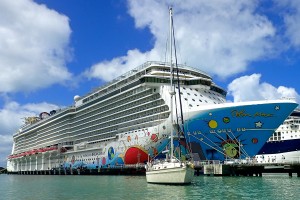
It all lasts about an hour, from first spotting the ship’s light in front of you to last seeing it behind you. It is the fastest hour of your five-hour overnight watch. Your heart pounds and your palms sweat. You are running around the cockpit to get the best view of the boat, to check the GPS and AIS. You consider waking the captain to see the spectacle. You jot illegible notes in the logbook. Finally the two ships pass in the night, and you are left with the wind, the waves, the bioluminescence, the moon, the stars, the captain snoring in the salon, Sunshine tied down up front and Moon Shadow dangling behind you. The sea settles, the wind fills, and you sail on, alone. As it should be.

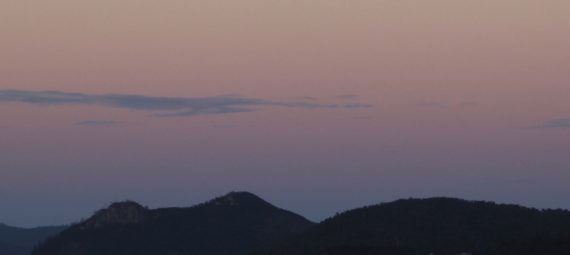
Hi Brita. Your entries make great reading and this one really captures the essence of being on solo night watch. Two miles seems like a hundred yards and the tension of determining if a collision course exists is palpable. One thing I puzzled on here was whether the ColRegs would confirm a sailing vessel as the stand-on in these situations. You’re right to suspect these large vessels may or may not see you; I would also not expect that if they do, they would or could alter course to avoid you. Just sayin…
Cold and rainy here, with more snow on the way. Stay warm!
Pulling into Statia today we were reminded of our days on the NY Harbor – oil tankers, tug boats and pilot boats zipping around. Wishing you a safe and prosperous season on the harbor. xo
Very nice description of night passages, Brita! Safe sailing!
Greg
SV Daystar
Thanks Greg. I’ve been enjoying reading your family’s blog as well.